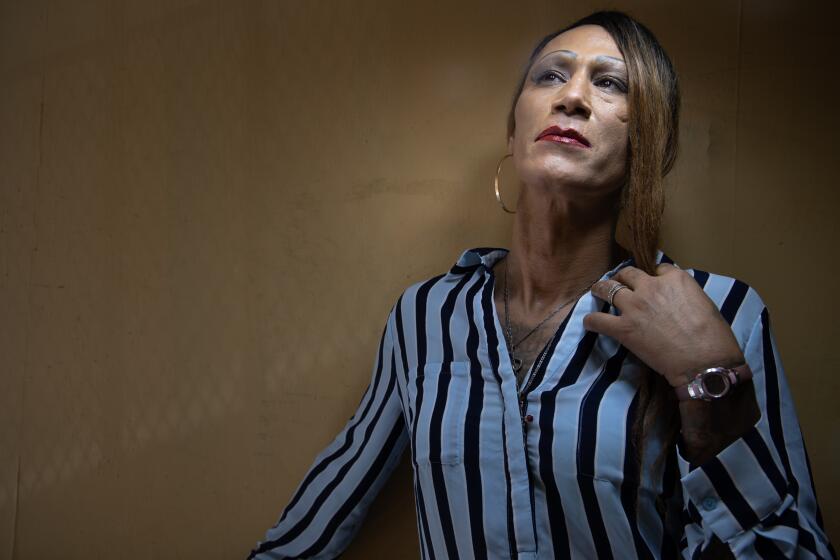A self-styled satanist beheaded his cellmate, but the guards didn’t notice, report says
The convicted killers shared the same cell at Corcoran State Prison. But on the morning of March 9, 2019, only one was still alive.
Jaime Osuna, 31, had decapitated and dissected the body of his cellmate, Luis Romero, 44, with a makeshift knife, state documents show.
But after prison guards made their rounds, they reported that both men were alive, according to two new reports on California prisons from the inspector general’s office.
The reports add fresh revelations and raise more questions about one of the most heinous slayings inside the California prison system. The killing has prompted investigations and a lawsuit over why Romero was in a cell with Osuna, a self-styled satanist with a history of attacking his cellmates. One of the reports also faults the California Department of Corrections and Rehabilitation for conducting a shoddy investigation and delaying disciplinary action against the guards.
One convicted killer has been accused of beheading another in what authorities call an exceptionally sadistic torture slaying at a California prison.
Why the officers did not discover the grisly scene early is not detailed in the reports. But a lawsuit by Romero’s family says the cell bars were covered by a white sheet, suggesting the guards failed to make a thorough check of the cell.
The Department of Corrections disputed the findings of the reports, saying in a statement it had conducted a “thorough and complete investigation from the very beginning.”
But the attorney for Romero’s family, Justin Sterling, said the reports outline the department’s “veil of secrecy” that obscures officer misconduct.
“The idea that my client had to sue in order to get basic questions answered about her son’s death is disheartening,” Sterling said.
California is giving 76,000 inmates, including violent felons, the opportunity to leave prison earlier under good behavior rules.
The guards were meant to check the cell every so often, Sterling said, and the crime would have taken hours to commit. If the guards had been doing their required checks, Romero would be alive today, he said.
Romero, who had spent 27 years in prison, was put in the cell with Osuna after arriving from Mule Creek State Prison, according to the lawsuit. He was convicted of second-degree murder after fatally shooting a woman in Compton when he was a teenager and associating with gang members. He was nearing parole eligibility.
His new cellmate, Osuna, was serving a life sentence for the killing and torture of Yvette Pena, 37, at a Bakersfield motel in 2011. With face tattoos and flair for Charles Manson-like satanic antics, he became a dark figure during the 2017 trial, mocking the victim’s family and bragging to a television news reporter of his love of torturing people.
Body cams in five prisons including Lancaster after abuse of disabled inmates, judge rules
Sometime in the early hours of March 9, 2019, Osuna methodically tortured and killed Romero, authorities said.
Using a razor-style blade attached to a handle, Osuna disfigured Romero, cutting out one of his eyes, chopping off one of his fingers and removing part of his ribs and slicing out part of his lung. He ultimately cut off his head. He also posed the body, slicing Romero’s face open on either side of his mouth to resemble an extended smile, according to an autopsy.
Guards found Osuna wearing a necklace made of Romero’s body parts.
Kings County Executive Assistant Dist. Atty. Phil Esbenshade called it the most heinous slaying he had ever seen. “We do believe that the victim was conscious during at least a portion of the time,” he said.
Osuna had never had a cellmate until Romero arrived two days earlier.
During his stint in a Kern County detention facility, he had been found with hatchets and other weapons and was deemed a “high-risk, staff assaultive” threat to guards, according to the lawsuit.
In one incident, Osuna found his way into another inmate’s cell, where he stabbed and slashed his face, resulting in 67 stitches, the lawsuit says. When prison officials requested to photograph the inmate’s injuries, he declined, noting that he didn’t want to risk Osuna getting copies of the photos and adding them to his collection of “trophies,” court records show.
There have been more than 260 requests for housing transfers this year under a new law that gives transgender, intersex and nonbinary inmates the right, regardless of anatomy, to be housed based on their gender identity.
Regular safety checks are considered an essential duty of prison guards, who must monitor the health of inmates and prevent assaults or suicides. Questionable behavior by guards has come under scrutiny in a New York case involving Jeffrey Epstein, who hanged himself in his prison cell while being held on child sex trafficking charges.
In Romero’s slaying, the Department of Corrections has declined to provide details about the guards’ activity.
According to the inspector general’s reports, the two officers falsely reported that they had observed Romero alive. Additionally, a third and fourth officer did not report they had each seen the first two officers “fail to properly conduct the counts,” according to one of the reports. Documents did not identify the prison or incident but used dates corresponding with Romero’s slaying.
The report also criticizes the prison department’s internal affairs investigation. It said that the first officer lied during the internal affairs interview and that the special agent in charge of the investigation did not interview several key witnesses. The agent also did not investigate whether it was appropriate to place the two killers together in a cell, according to the report.
The inspector general’s reports also took issue with the disciplinary measures taken against two of the officers who were on duty, according to a case summary of the investigation obtained by The Times. One officer accused of lying to the internal affairs agent was initially fired, and the salary of the second officer was cut 5% for three years. But after the officers appealed to the State Personnel Board, the department reached a settlement: The first officer’s dismissal was reduced to a nine-month suspension, and the second officer’s salary reduction was reduced to 24 months, the case summary shows.
“The department’s handling of the case was poor,” the inspector general’s office said. “In the OIG’s opinion, the special agent continually resisted the recommendations of the department attorney regarding conducting interviews and obtaining evidence,” the report said.
Osuna has been transferred to Salinas Valley State Prison’s psychiatric inpatient program. He has been diagnosed with unspecified schizophrenia spectrum, antisocial personality disorder and borderline personality disorder.
A judge has ruled that Osuna is not competent to stand trial for Romero’s death.
More to Read
Sign up for Essential California
The most important California stories and recommendations in your inbox every morning.
You may occasionally receive promotional content from the Los Angeles Times.














